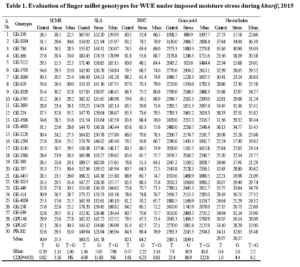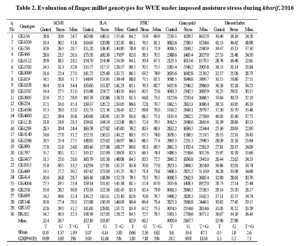EVALUATION OF FINGER MILLET ENOTYPES FOR DROUGHT TOLERANCE UNDER MOISTURE STRESS CONDITIONS
0 Views
P. PRANUSHA, V. RAJARAJSWARI, H.S. TALWAR, P.LATHA AND K.N.GANAPATHY
Department of Crop Physiology, S.V. Agricultural College, ANGRAU, Tirupati– 517502, Chittoor (Dist.) Andhra Pradesh
ABSTRACT
The present study was conducted with an aim to evaluate the effect of moisture stress on water use efficiency traits viz., SPAD chlorophyll meter readings (SCMR), Specific leaf area (SLA), Relative water content (RWC)and yield parameters in 30 finger millet genotypes. The experiment was conducted in randomized block design with three replications, under rainout shelter. Moisture stress was imposed from panicle initiation to grain filling period. The genotypes GE-1043, GE-224, GE-639 and GE-1013 performed better than other genotypes and recorded higher SCMR values, low SLA, higher RWC, higher grain yield and higher harvest index.
KEY WORDS:
Finger millet, moisture stress, SCMR, SLA, RWC.
INTRODUCTION
Finger millet (Eleusine coracana (L.) Gaertn) is called as ragi, mandua, bird’s foot, nagli, etc., in different regions of India. It is the third most important millet crop of India, grown mainly by subsistence farmers. Moisture stress during crop growth period especially in kharif growing season accounts for 70 per cent loss in productivity. Screening and selection of plants of different crops with considerable water stress tolerance has been considered an economic and efficient means of utilizing drought-prone areas when combined with appropriate management practices to reduce water loss (Rehman et al., 2005). Hence the water use efficiency traits (SLA, SCMR, and RWC) and yield traits are the reliable drought tolerance traits for evaluating the genotypes. Therefore information on water use efficiency traits of finger millet genotypes is more important in the crop improvement programme to evolve varieties suitable for rainfed situations. Hence the present study was formulated with an objective to evaluate the WUE traits under imposed moisture stress conditions among selected genotypes under field conditions.
MATERIALS AND METHODS
The experiment was conducted at IIMR (Indian Institute of Millet Research), Hyderabad during kharif 2015 and 2016 in a Randomized Block Design (RBD) replicated thrice with 30finger millet genotypes and moisture stress was imposed from panicle initiation to grain filling stage under rainout shelter. Prophylactic measures were taken for protecting the crop from pest and diseases. Water Use Efficiency (WUE) was measured using surrogate measure i.e. SPAD Chlorophyll Meter Reading (SCMR).The SPAD-502 (Soil Plant Analytical Development) meter was used for measuring the relative chlorophyll content of the leaves. Specific leaf area (SLA) was computed by following formula as SLA = A /WL Where A = Leaf area; WL = Leaf dry weight at time t). Relative water content (RWC %) was calculated following Barrs and Weatherly (1962) as RWC (%) = [fresh weight-dry weight /Turgid weight-Dry weight) x 100].The data on seed yield and yield components were recorded at the time of harvest. The data were statistically analyzed as described by Panse and Sukhatme (1985).
RESULTS AND DISCUSSION
SCMR and SLA values were well established as reliable surrogate traits for WUE in many crops. SCMR obtained under control and moisture stress conditions at grain filling stage was given in Table 1. There was significant decrease in SCMR values with moisture stress in all genotypes. Significant differences were observed among the genotypes and treatments. Similar significant differences between genotypes under irrigated as well as moisture stress were reported in finger millet (Maqsood and Ali, 2007).SPAD values varied significantly within the genotypes at grain filling stage. Among the genotypes tested GE-1034, GE-639, GE-224 and GE-1013 possessed comparable greenness under moisture stress at grain filling stage.
There is a significant decrease in SLA values with moisture stress in all genotypes, GP-1034 recorded higher SCMR, however it maintained lower SLA values at grain filling stage. Since low SLA and high SCMR are the indicators for high WUE, genotypes GP-1013 and GP-224had high WUE. These results are in agreement with (Nageswara Rao et al. 1993,Talwar et al., 2004 and Latha, 2004). Wright et al. (1994) reported an inverse relationship between SLA and WUE, thus indicating that genotypes with thick leaves (low SLA) under moisture stress conditions may be water use efficient.
RWC is an important indicator of water deficit stress in leaves (Sairam et al., 1997) gives a picture of cell membranestability.RWC indicate the water status of the cells and have significant association with yield and stress tolerance. RWC values obtained under control and moisture stress conditions at panicle initiation stage were given in (Table 1). There was a significant decrease in RWC values with moisture stress in all genotypes. Similar significant differences between genotypes under irrigated as well as moisture stress was reported in wheat(Moaedalmeselmani et al., 2012) rabi sorghum (Surwenshi et al., 2010).Similar results were also reported in Bermuda grass which had relative water content (85.62 %) was found to be most drought tolerant followed by
Zoysia japonica which is best suitable for stress tolerant conditions. (Ubendra et al., 2015).Thus the leaf tissue maintained low water content, indicating that GE-5112, GE-156 and GE-4004 genotypes as susceptible under stress condition. Among the genotypes, GE-1034, GE-639 and GE-224 maintained significantly higher RWC values at grain filling stage. This indicates that maintenance of higher water status under drought plays an important role in building grain yield. Among the genotypes GE-1034 recorded significantly higher grain yield followed by GE-224 and GE-1013 (Table 2).The genotypes GE-5112, GP-
156 and GP-4004 recorded poor yield under moisture stress conditions, despite of recording higher yields under irrigated conditions. Similar results of decrease in the grain yield due to moisture stress were reported in proso millet (Seghatoleslami et al., 2008).
Among the tested genotypes GE-224 recorded highest mean harvest index followed by GE-1034 compared to other genotypes. The higher harvest index of these genotypes represents an increased physiological capacity to mobilize photosynthates and translocate them efficiently to organs of economic value, i.e. grain yield as opined by Wallace et al., (1972).This present study concluded that the three genotypes GE- 1034, GE-639 and GE-224 maintained significantly higher values regarding SCMR, RWC and lower SLA. These genotypes also maintained high grain yield and its attributes. Hence the segenotypes are considered to possess high WUE and other drought tolerance traits and grain yield. The information obtained from these traits in the present study may be used to develop high yielding finger millet varieties suitable for rainfed conditions.


REFERENCES
- Barrs, H. D and Weatherley, P. E. 1962. A re-examination of therelative turgidity techniques for estimating water deficits in leaves. Australian Journal of Biological Science.15: 413-428.
- Latha, P. 2004. Genotypic variation for water use efficiency in advancedbreeding lines of groundnut developed through trait and empiricalmethods under moisture stress M.Sc. (Ag.) Thesis, ANGRAU, Hyderabad.
- MoaedAlmeselmani., Abd Al Razak Saud., Fouad Hareri., Mahran Al-Nasan., Mohammad Adel Ammar., Osama ZuherKanbar and Hani Al-Naseef. 2012. Physiological traits associated with drought toleranceof Syrian durum wheat varieties under rainfed conditions. Indian Journal of Plant Physiology.17(2): 166-169.
- Maqsood, M and Azam Ali, S. N. 2007.Effects of environmental stress on growth, Radiation use efficiency and yield of finger Millet (Eleucine coracana). Pakistan Journal of Botony.39(2): 463-474.
- NageswaraRao, R. C., Williams, J. H., Wadia, K. D. R., Hubick, K.T and Farquhar, G. D. 1993. Crop growth, Water use efficiency and carbon isotope discrimination in groundnut (Arachis hypogaea L.) genotypes under end of season drought conditions. Annals of Applied Biology. 122: 357-367.
- Panse, V. G and Sukhatme, P. V. 1985. Statistical Methods for Agricultural Workers, ICAR, New Delhi.
- Rehman, S., Harris, P.J.C and Ashraf, M. 2005. Stress Environments and their impact on crop product–ion. In: Abiotic Stresses: Plant Resistance Through Breeding and Molecular Approach–es. M. Ashraf and P.J.C. Harris (eds). The Har–worth Press Inc., NY, pp 3-18
- Sairam, R. K., Deshmukh, P. S. and Shukla, D. S. 1997. Tolerance todrought and temperature stress in relation to increased antioxidant enzyme activity in wheat. Journal of Agronomy and Crop Science. 178: 171-177.
- Seghatoleslami, M. J., Kafi, M. and Majidi, E. 2008. Effect of deficit irrigation on yield, WUE and some morphological and phonological traits of three millet species. Pakisthan Journal of Botany.40(4): 1555-1560.
- Surwenshi, A., Chimmad, V.P., JalageriB.R., Vinod Kumar, Ganapathi, M and Nakul, H.T(2010). Characterization of Sorghum Genotypes for Physiological Parameters and Yield under Receding Soil Moisture Conditions. Research Journal of Agricultural Sciences.1(3): 242-244
- Talwar, H. S., NageswaraRao, R., Nigam, S. N and Wright, G. C.2004. Leaf anatomical characteristics associated with water use efficiency in groundnut
- ( Arachis hypogaea L.). Proceedings of National Seminar: Enhancing Productivity of groundnut for sustaining food and nutritional security, 11-13, October 2004, NRCG, Junagadh.
- Ubendra, Jawaharlal, M and Subeshranjithkumar, C. 2015.Evaluationof turf grass species suitable for tropical conditions based on quantitative and qualitative traits. The Bioscan. 10(3): 1021-1026.
- Wallace, J. R., Ozbun, J. L and Munger, H. M. 1972. Physiological genetics of crops yield. Advances in Agronomy. 24: 97-146.
- Wright, G. C., Rao, R. C. N and Farquhar, G. D. 1994. Water-use efficiency and carbon isotope discrimination in peanut under water deficit conditions. Crop Science. 34: 92-97.
- Bio-Formulations for Plant Growth-Promoting Streptomyces SP.
- Brand Preference of Farmers for Maize Seed
- Issues That Consumer Experience Towards Online Food Delivery (Ofd) Services in Tirupati City
- Influence of High Density Planting on Yield Parameters of Super Early and Mid Early Varieties of Redgram (Cajanus Cajan (L.) Millsp.)
- Influence of Iron, Zinc and Supplemental N P K on Yield and Yield Attributes of Dry Direct Sown Rice
- Effect of Soil and Foliar Application of Nutrients on the Performance of Bold Seeded Groundnut (Arachis Hypogaea L.)

